Research Article :
Salah Ahmed Shoheb, Mohamed A.El-Gamasy Background: Breast milk adiponectin could play a
role in regulation of infants, growth during lactation. Aim of work: To evaluate adiponectin concentration
in human milk and to investigate its relationship with serum adiponectin
concentration in lactating mothers and their breastfed infants and with
anthropometric parameters of infants and mothers. Materials and methods: 60 healthy term infants and their
healthy lactating mothers are included at infant age of one month then repeated
again at the age of 4 months. All subjects included in this study were
subjected to history, clinical examination, investigations including serum
level of adiponectin of infants and their mothers by RIA test, Human milk level
of adiponectin by ELIZA test. Results: There was a significant decrease in serum adiponectin of
infant and mothers and maternal breast milk at age of 4 months (48 ± 6.5,13 ±
1.7, 5.3 ± 2 respectively) when compared to them at the age of 1 month (62.6 ±
1.5, 21.4 ± 5.6, 13.4 ± 3.8 respectively). There was a significant negative
correlation between maternalserum adiponectin and BMI of mothers. There was a
significant negative correlation between infant serum adiponectin and their
weight and length of infants at age of 1 month and at age of 4 months. Conclusions: There’s a metabolic link between
mothers and their infants through breast milk during 1st 6 months of life. A
gradual decline in adiponectin level in maternal breast milk is associated with
gradual increase in infant growth up to 6 months of age. Serum
adiponectin in infants and mothers as well as in breast milk reach its maximal level
during first 6 months of life so exclusive breast feeding should be encouraged.
It is recommended to measure infants serum adiponectin level as well as their
mothers serum and breast milk adiponectin especially in infants with retarded
growth to exclude hyperadiponectinemia as a possible cause of growth failure. Human
milk contains a wide variety of high biological value proteins that provide adequate
nutrition to breast fed infants and simultaneously help in the development of important
physiological functions. Adiponectin, one of the most important hormones
related to adipose depots, In addition to its peripheral actions regulating
lipids and glucose metabolism [1], adiponectin has central activity in the
regulation of energy homeostasis stimulate food intake and reducing energy
expenditure [2]. Adiponectin
circulates in human blood as three distinct isomeric forms: Trimeric low
molecular weight, hexameric medium molecular weight and high molecular weight
(HMW) adiponectin, which consist of large multimers of 12-18 subunits [3]. Recent
evidences suggest that HMW adiponectin is the most active form exerting metabolic
functions and it is the most abundant form present in HM, suggesting that milk
adiponectin could play a significant role in early regulation of infants,
growth during lactation [3]. Its plasma concentrations range from 0.5 to 30 μg/
ml, 1000 fold higher than the concentrations of other hormones, such as leptin
[2]. A great evidence suggest that adiponectin serum concentration in neonates
and infants is higher than those found in children and adults [4,5]. In
previous studies, it has been observed a direct association between cord blood
adiponectin concentration and birth weight [4], while other studies have not
confirmed this correlation [6]. These finding suggest that prenatal and early
post-natal periods are critical for the development of metabolic homeostasis
and that adiponectin could play a role in programming of energy balance [7]. The
aim of the work is to evaluate adiponectin concentration in human milk and to
investigate its relationship with serum adiponectin concentration in lactating
mothers and their breastfed infants and with infants, and mothers,
anthropometric parameters (weight and length). Design
of the study and setting after
research ethical committee approval and informed oral or written parental
consent from all participants in this research, we performed a cross-sectional
study on 60 healthy term infants and their healthy lactating mothers at age of
one month then had been studied again at the age of 4 months. All the subjects
that enrolled in our study were seen in outpatient clinic of primary health
care hospital for brief observation for mild pathological conditions. The study
was done in the period between June 2016 and June 2017. Inclusion criteria: Chronological
age less than 6 months, Gestational age between 38-42 weeks, Birth weight
between 2500-4000 grams, APGAR score higher than 7 at 5 minutes and exclusively
breast fed infants. Exclusion criteria: Neonatal
diseases, fever, chronic illness, acute disorder compromising growth e.g. acute
gastroenteritis or partial breastfeeding. All infants & their lactating
mothers included in this study were subjected to the following: Full
history taking stressing on duration of exclusive breast feeding Through clinical examination stressing on Anthropometric evaluation: Infants
were weighted naked before feeding, crownto-heel length was measured and body
mass index (BMI) was calculated
by the relation: body weight (Kg) / square of length (m2).We were evaluated
anthropometric parameters also in mothers: weight (Kg), height (m) and body
mass index (BMI). All anthropometric measurements were taken by a single
trained investigator. Laboratory investigation:
Serum level of adiponectin for mothers and infants measured by radioimmunoassay
test and level of maternal breast milk adiponectin measured by enzyme-linked immunosorbent
assay (human adiponectin ELISA kit catalog NoE0605h,Wuhan EIAab Science Co.,
Ltd, Wuhan, China). Statistical Analysis Data
were collected and analyzed using SPSS for windows (version 12). All Data were
expressed in terms of mean ± SD. Comparisons among groups were made using
paired t test. Twogroup comparisons were performed non-parametrically using Mann-Whitney
U test. All statistical tests were two tailed and P<0.05 was considered
statistically significant [8]. Our
results showed that 24 (40%) of studied infants were males and 36 (60%) were
females with male: female ratio 1: 1.5. Tabel 1 summarized baseline
characteristic data of the studied infants and their mothers. This study showed
that there is no significant difference in serum adiponectin of infants as
regard sex (p>0.05) (Table 1). Table 2 and Figure 2 revealed that there was a
significant decrease in serum adiponectin of infant and mothers and maternal
breast milk adiponectin at age of 4 months when compared to them at the age of
1 month. Table 2 & 3 and Figures 3
and 4 revealed that there was a significant positive correlation between infant
serum adiponection, maternal serum adiponectin and breast milk adiponectin at
infant age of 1 month but there was a significant negative correlation between
infant serum adiponectin and their anthropometric parameters (weight &
length & BMI) of infants at age of 1 month and at age of 4 months. Table 4
and Figure 5 revealed that there was a significant negative correlation between
maternal serum adiponectin and body mass index (BMI) of mothers. Table 1: Baseline characteristics od studied infants and their Table 2: Comparison between serum adiponectin of infants as regard to sex. Table 3: Comparison between levels of adiponectin of infants’ serum, maternal serum and breast milk as regard the age of the studied Figure 1: Comparison between serum adiponectin of infants as Table 4: Correlations between infant serum adiponectin and its level in maternal serum & breast milk and anthropometric measurements of Table 5: Correlations between maternal serum adiponectin, breast milk adiponectin & body mass index (BMI) of mothers at infant age As
regards to the demographic data, the results showed that 8 out of 20 infants (40%)
were males and 12 (60%) were females with male: female ratio 1: 1.5.This study
showed that there is no significant difference in serum adiponectin of infants
as regard sex (p>0.05).These results were in agreement with a study carried
by Inami I, et al which revealed that there is no significant difference in
serum adiponectin of infants between males and females at age of 1 month [12]. As
regard this study, there is a highly significant decrease in serum adiponectin
of infants at age of 4 months when compared to it at age of 1 month (62.6 ± 1.5
versus 48 ± 6.5) (P<0.01). These results were in agreement with Cesur G, et
al who revealed that mean of infant serum adiponectin was 15.09 ± 7.81μg/ml at
age of 1 month and was 6.60 ± 7.46 μg/mlat age of 4 months (P<0.05) [13].
Our results were also in agreement with Woo JG, et al., who revealed that there
is a highly significant decrease in serum adiponectin of infants at age of 12
months (mean= 23.5 ± 0.8 μg/ml
) when compared to it at age of 6 months (mean= 28.6 ± 0.6 μg/ ml) and there is
a highly significant decrease in serum adiponectin of infants at age of 6
months when compared to it at age of 3 months (mean= 33.2 ± 0.5 μg/ml) but
there is significant increase in infant serum adiponectin between base line (
mean=31.1 ± 0.6 μg/ml) and at 3 month (p<0.01) [14]. As regard adiponectin
in maternal breast milk in our study, there is a highly significant decrease of
its levels at infants, age of 4 month when compared to it at age of 1 month
(5.3 ± 2 versus 13.4 ± 3.8) (p<0.001).These results were in agreement with a
study carried by Burner S, et al. who revealed that the median values
of both leptin and adiponectin in maternal breast milk were slightly lower at
infants, age of 4 month median= 0.09 ng/ml and 10.36 ng/ml) respectively when
compared to them at infants, age of 6weeks (median= 0.11 ng/ml and 10.93ng/ml)
respectively (P<0.001) [15]. Another study carried by Bronsky J, et al.
revealed that mean value of adiponectin level of breast milk at infants birth was
changeable (22.8 ± 0.8 ng/ml, at age of 1month, 20.5 ± 0.6 ng/ml
was at age of 3 months and 21.4 ± 0.8 ng/ml was at age of 6 months) [16]. Other
studies such as a study carried by Cesur G, et al. which revealed no
significant difference between maternal breast milk adiponectin at infants, age
of 1 month ( mean= 23.61 ± 32.95 ng/ml) and at age of 4 months ( mean= 6.66 ±
9.48 ng/ml) (P
> 0.05) [13]. Figure 2: Correlation between infant serum adiponectin and weight of infant at age of 1 months. Figure 3: Correlation between infant serum adiponectin and length of infant at age of 4 months In
our study, as regard maternal serum adiponectin, there is a highly significant
decrease of maternal serum adiponectinat infants, age of 4 months when compared
to it at infants, age of 1month (21.4 ± 5.6 versus 13 ± 1.7 ) (P<0.01).
These results were in agreement with Burner S, et al. who revealed that there
was a slight decrease in maternal plasma level of high molecular weight adiponectin
at infant age of 4 months when compared to it at infant age
of 6 weeks with a significant decrease over time [15]. Our results disagreed
with a study carried out by Cesur G, et al which revealed that theres no
significant difference in maternal serum adiponectin at infants, age of 4
months(mean=7.75 ± 3.67μg/ ml) and at infants, age of 1 month (mean=8.36 ± 6.46μg/ml)
(P > 0.05) [13]. In our study, there is a significant positive correlation
between infant serum adiponectin and their maternal breast milk adiponectinat
infants, age of 1 month (r=0.785) (p<0.001). and there is a significant
positive correlation between infant
serum adiponectin and maternal serum adiponectin at infants,
age of 1 month (r = 0.774) respectively (p<0.001). These results were in
agreement with Woo JG, et al. who revealed that higher infant serum adiponectin
was associated with feeding with breast milk which contains higher level of
adiponectin than artificial formula so there is a positive significant
correlation between infant and their maternal serum adiponectin (r = 0.29 &
p = 0.007) and (r= 0.37 & P= 0.001) at age of birth and 6 months respectively
[14]. In our study, there is a significant positive correlation between
maternal serum adiponectin and maternal breast milk adiponectin at infants, age
of 1 month (r = 0.784) (P = 0.001). These results were in agreement with Woo JG, et al. who revealed that
maternal serum adiponectin was significantly correlated with their own median
breast milk adiponectin concentration at base line, 3 months and 6 months (r =
0.37 & P<0.001). (14) Also these results were in agreement with Burner
S, et al 2014 who revealed that theres a high significant positive correlation
between plasma and breast milk levels of adiponectin at infants age of 6 weeks
and 4 months (P<0.001) [15] while these results disagreed with Cesur G, et
al who revealed that there was no significant correlation between maternal
barest milk and their serum adiponectin (P > 0.05) [13]. Figure 4: Correlation between infant serum adiponectin and body mass index (BMI) of infant at age of 4 months. Figure 5: Correlation between maternal serum adiponectin & body mass index (BMI) of mothers. This study showed that there is a significant negative correlation
between maternal serum adiponectin and their body mass index (BMI at infants
age of 1 month (r = - 0.769 & p = 0.001). These results were in agreement
with Matsubara M , et al who revealed that plasma concentration of adiponectin
in mothers with highest percentile of BMI (at least 25 kg /m2) were lower than
these in the middle (22-25 kg /m2) or lowest (<22kg /m2) percentile of BMI (Mean=6.7 ± 0.3 μg/ml versus 8.6 ± 0.4μg/ml versus 9.2 ±
0.3μg/ml respectively) (P<0.001) [16]. This also in agreement with Nedvidk
J, et al. [17] who revealed that adiponectin release in mothers serum is
positively correlated with fat size and negatively correlated with BMI. Our
results are in agreement also with Hirose H , et al 2010 which revealed that
maternal serum high molecular weight (HMW ) adiponectin was negatively correlated
with their BMI (mean= 20.6 ± 2.9) (r = - 0.216 & P<0.001) also change in
HMW adiponectin level was most strongly correlated with the change in BMI [18]. This study showed that there is a significant negative correlation
between infants, serum adiponectin and their anthropometric measurements
(weight &length) at infants age of 1 month and at infants, age of 4 months.
These results were disagreed by a study carried out by Cesur G, et al, [13]
which revealed that there is a significant positive correlation between level
of infant serum adiponectin at age of 1 month and their weight (r = 0.53 &
P = 0.020) and also infant serum adiponectin were positively correlated with
weight (r = 0.61 &P = 0.006), BMI (r = 0.71 & P = 0.001) at age of 4
months. Conclusions Strengths of this study was it concluded that there was correlations
between maternal serum, breast milk adiponectin and infants serum adiponectin which suggested that theres was a
metabolic link between mothers and their infants through breast milk during 1st
6 months of life and that milk adiponectin could play a significant role in
early regulation of infants growth during lactation. Our results suggest that a
gradual decline in adiponectin level in maternal breast milk is associated with
greater growth (weight gain and fat mass) in their infants up to 6 months of
age. Recommendations We recommend encouragements of breast feeding for all infants
except for rare contraindications for this beneficial type of feeding.
Exclusive breast feeding is essential for 6 months because serum adiponectin in
infants and mothers as well as in breast milk reach its maximal level during 6
months of life. Measurement of maternal serum &breast milk adiponectin and
infant, serum adiponectin in the first 6 months of life is important for
assessing adequate growth of these infants. In infants with retarded growth (weight
and / or height), it is recommended to measure their serum adiponectin level as well as their mothers serum and breast milk
adiponectin to exclude hyper diponectinemia
as a possible cause of growth failure and that need further research work. 1. Savino F, Petrucci E, Nanni G. Adiponectin: An intriguing
hormone for pediatricians (2008) ActaPaediatr 97: 701-705. Human milk, Adiponectin, Anthropometric parameters
Metabolic-Link-of-Human-Milk:-Effects-on-Weight,-Length-and-Body-Mass-Index-(BMI)
Abstract
Full-Text
Introduction
Materials and Methods
Results
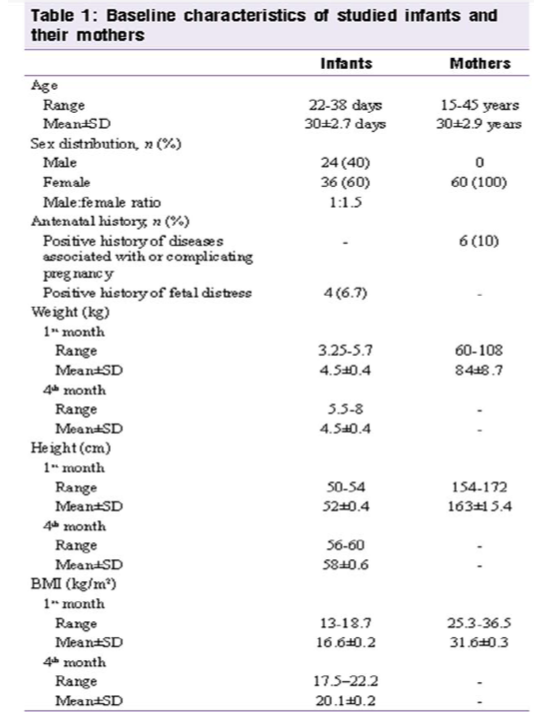

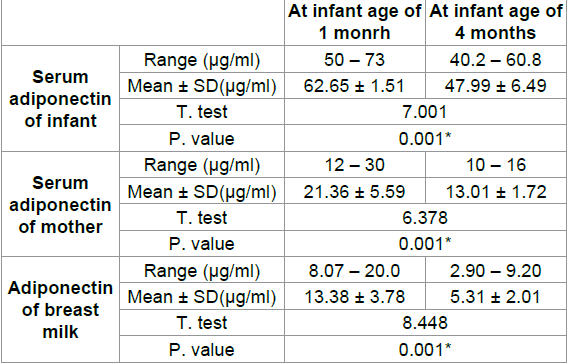

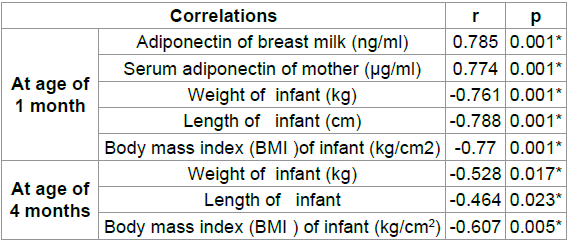

Discussion
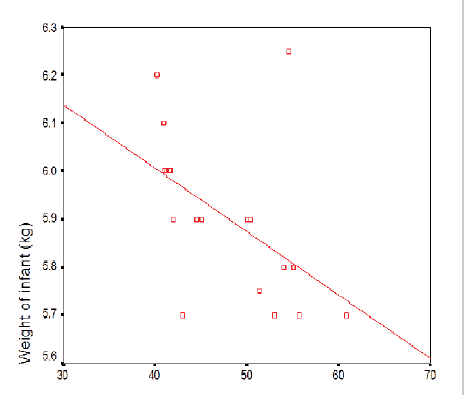
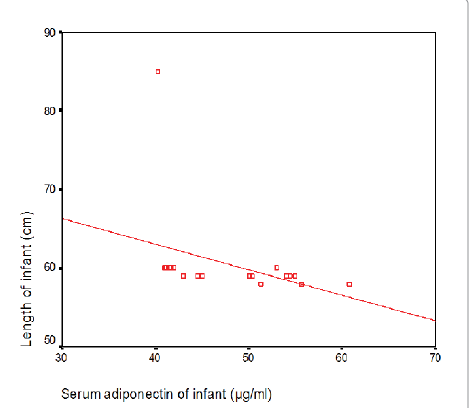
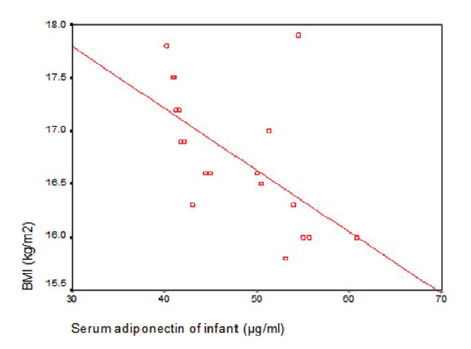
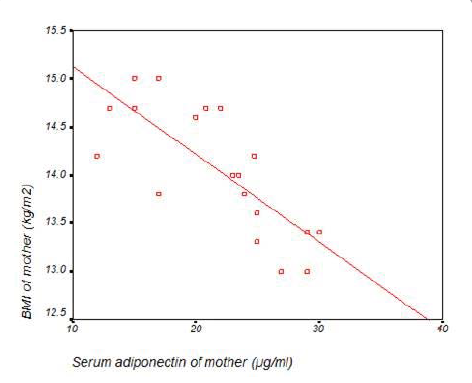
References
2. Newburg DS, woo JG, Morrow AL. Characteristic and potential functions
of human milk adiponectin (2010) J Pediatr 156:S 41-46.
3. Schondrof T, Maiworm A, Emmison N , Forst T, Pfützner A, et al.
Biological background and role of adiponectin as marker for insulin resistance and cardiovascular risk (2005) Clin Lab 5: 489-494.
4. Kotani Y,Yokota I, kitamura S, Matsuda J, Naito E, Kuroda Y, et
al. Plasma adiponectin levels in new born are higher than those in adult and positively correlated with birth weight (2004)Clinendocrinol
61: 418-423.
5. Iniguez G, Soto N, Avila A, Salazar T, Ong K, Dunger D, et al. Adiponectin
levels in first two years of life in a prospective cohort:Relations with weight gain, leptin levels and insulin sensitivity (2004)
J Clin Endocrinol Metab 11: 5500-5503.
6. Lindasy RS, Walke JD, Havel PJ, Hamilton BA, Calder AA, Johnstone
FD, et al. Scottish multicenter study of diabetes pregnancy. Adiponectin is present in cord blood but is unrelated
to birth weight (2003) Diabetes Care 26: 2244-2249.
7. Savino F, Liguria SA, Lupica MM. Adipokines in breast milk and preterm
infants (2010) Early Hum Dev 86: 77-80.
8. Khothari CR Research methodology (2012) Methods and Techniques,
New Age International, New Delhi, Pp: 95-97.
9. Savio F, Liguori SA, Petrucci E, Lupica MM, Fissore MF, Oggero R,
et al. Evaluation of leptin in breast milk, lactating mothers and their infants (2010) Eur J ClinNutr 64: 972-977.
10. Martin LJ, woo JG, Geraghty SR, Altaye M, Davidson BS, Banach W,
et al. Adiponectin is present in human milk and is associated with maternal
factors (2006) Am j clin nutr 83:1106-1111.
11. Bronsky J, Mitrova K, Karpisek M, Mazoch J, Durilova M,
Fisarkova B, et al. Adiponectin, AFABP and Leptin in human breast milk during
12 months of lactation (2011) J Pediatr Gastroenterol Nutr 52: 474-477.
12. Inami I, Okada T, Fujita H, Makimoto M, Hosono S, Minato M, et
al. Impact of serum adiponectin concentration on birth size and early post-natal growth (2007) Pediatr Res 61 : 604-606 .
13. Cesur G, Ozguner F, Yilmaz N, Dundar B. et al. The
relationship between ghrelin and adiponectin levels in breast milk and infant serum and growth of infants during early postnatal life (2012) J Physiol
Sci 62: 185-190.
14. Woo JG, Guerrero ML, Guo F, Martin LJ, Davidson BS, Ortega H,
et al. Human milk adiponectin impacts infant weight trajectory during second year of life (2011) J pediatr Gastroenterol Nutr 54:
532 - 539.
15. Burner S, Schmid D, Zang K, Much D, Knoeferl B, Kratzsch J, et
al. Breast milk leptin and adiponectin in relation to infant body composition up to 2 years (2014) Pediatric obesity 10: 67-73.
16. Matsubara M, Marouka S, Katayose S. Inverse relationship between
plasma adiponectin and leptin concentration in normal weight and obese women (2002) Eur J Endocrinol 147:173-180.
17. Nedvidk J, Smitka K, Kopsky V, Hainer V, et al. Adiponectin,
an adipocyte- derived protein (2005) Physiol Res 54:133- 140.
18. Hirose H, Yammamoto Y, Seino- Yoshihara Y, Kawabe H, Saito I,
et al. Serum high molecular weight adiponectin as a marker for the evaluation
and care of subjects with metabolic syndrome and related disorders (2010) J
Atheroscler Thromb 17: 1201 - 1211. Keywords